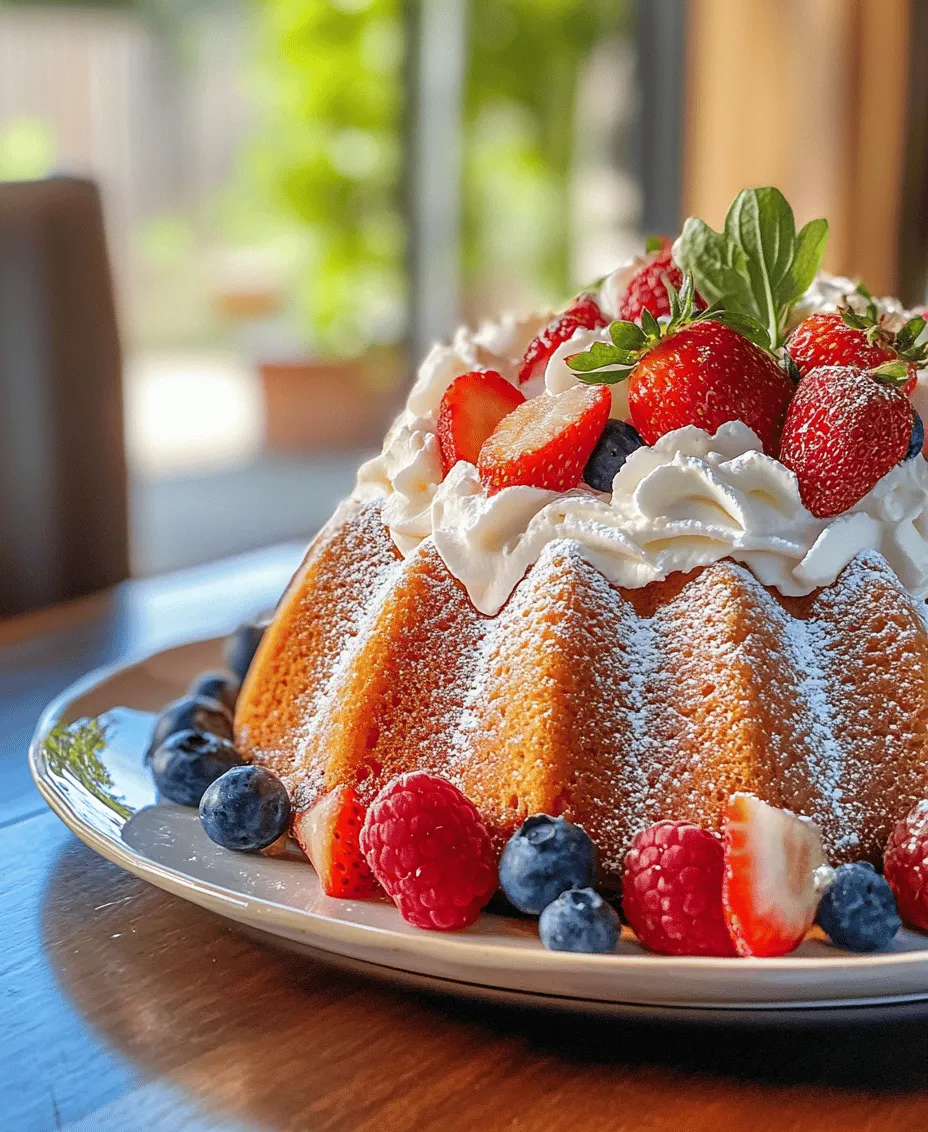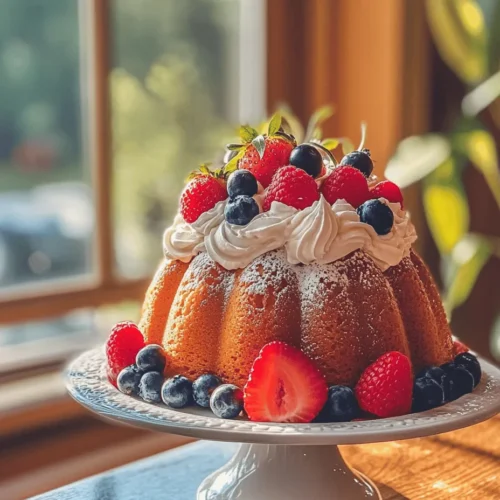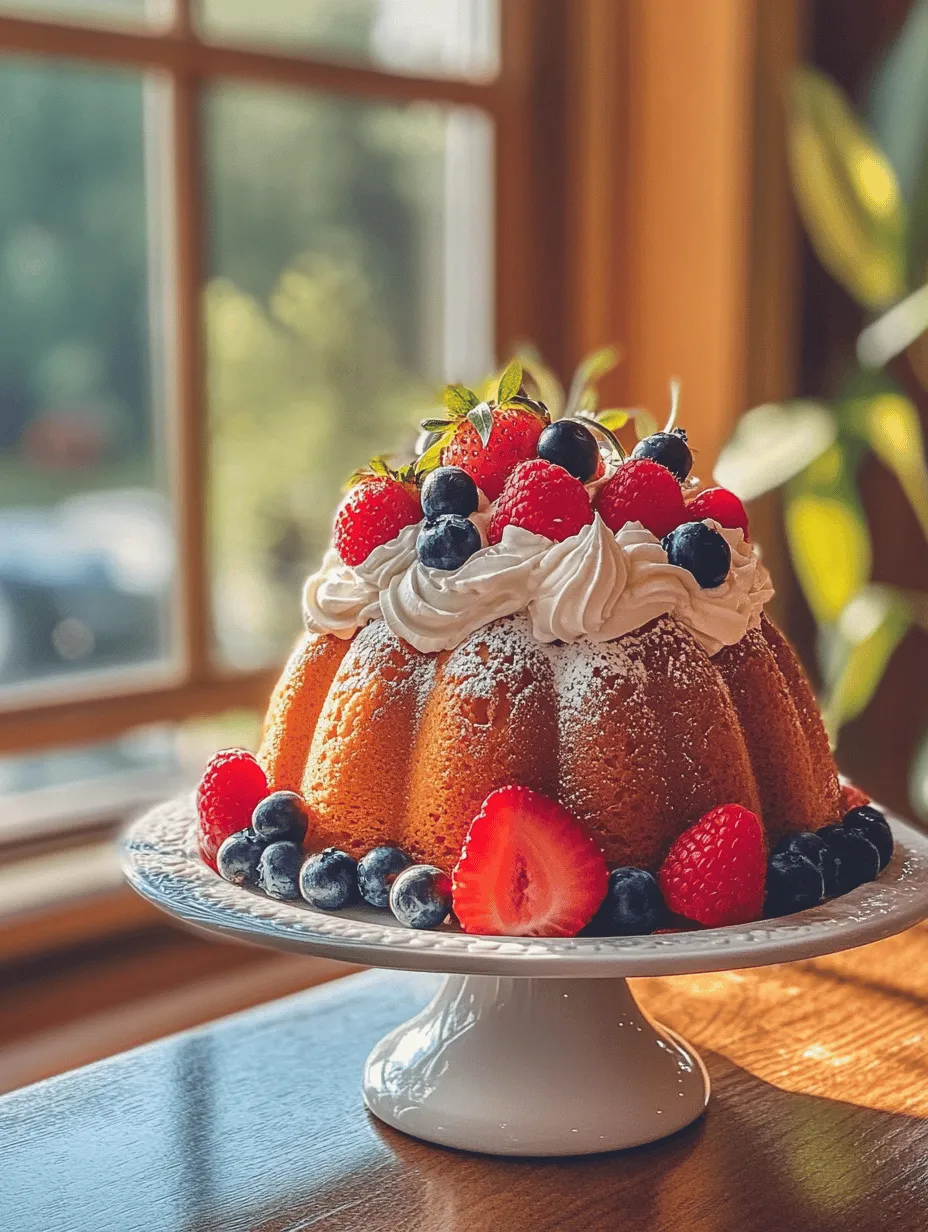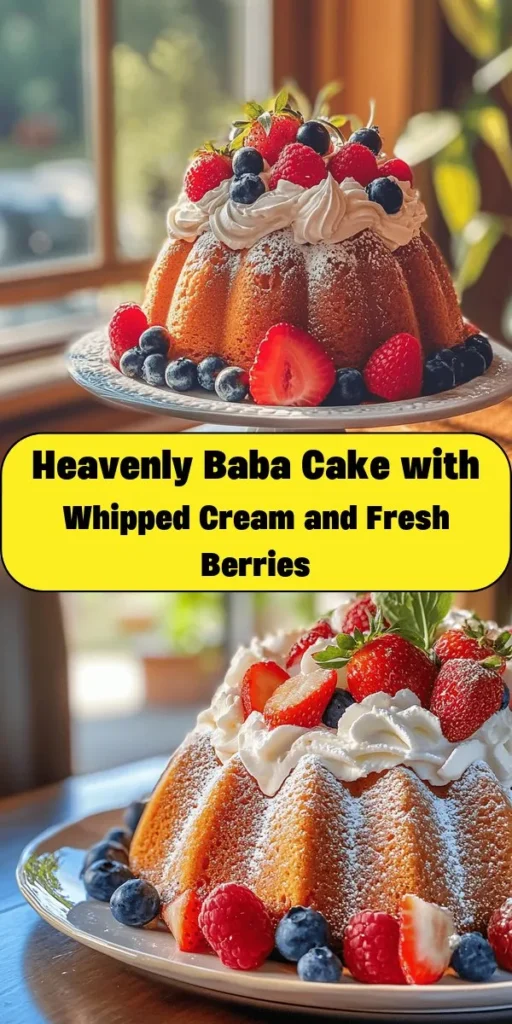Introduction
Baba Cake, a rich and moist dessert, has captured the hearts of many across the globe. With its origins rooted in Eastern European traditions, this delightful cake is celebrated for its unique texture and sumptuous flavor. Traditionally soaked in rum or other spirits, Baba Cake has evolved over the years, finding its way into various culinary cultures. Today, we present to you the Baba Cake Delight, an alcohol-free version that retains all the charm and flavor of the classic recipe, making it perfect for everyone, including families and children.
Homemade desserts hold a special place in our hearts, evoking fond memories of baking sessions with loved ones, the aroma of sweets wafting through the kitchen, and the joy of sharing a lovingly made treat. The Baba Cake Delight embodies this spirit of homemade goodness, offering a moist, fluffy cake that can be enjoyed at any gathering, from birthdays to holiday celebrations. In this article, we will delve into the rich history of Baba Cake, explore its variations, and guide you through the process of creating your very own Baba Cake Delight.
Understanding Baba Cake
The history of Baba Cake dates back to the 18th century, believed to have originated in Poland and later popularized in France, where it received its iconic name “baba.” The term “baba” is derived from the Polish word “baba,” meaning “grandmother,” which reflects the cake’s comforting and nostalgic qualities. Traditionally, Baba Cake is made from a yeast-based dough that is soaked in a syrup, often flavored with rum or other spirits, giving it a moist and indulgent consistency.
As culinary practices spread and evolved, variations of Baba Cake emerged across different cultures. In Italy, for instance, the Baba al Rum is a classic version, while in the Caribbean, the cake is often infused with local flavors and spices. Each variation carries a unique touch, yet all share the common theme of a moist, rich cake that has become synonymous with celebration and indulgence.
Baba Cake holds a significant place in various celebrations and gatherings. In many cultures, it is served during festive occasions, symbolizing joy and togetherness. Its versatility allows it to be dressed up with various toppings, from whipped cream and fresh fruits to chocolate ganache, making it a favorite for both casual gatherings and formal events.
Ingredients Breakdown
Creating the perfect Baba Cake Delight begins with understanding the ingredients that contribute to its delightful texture and flavor. Each component plays a crucial role in ensuring that the cake turns out perfectly every time.
All-Purpose Flour
All-purpose flour is the backbone of any cake recipe, and it is no different for our Baba Cake Delight. This versatile ingredient provides the necessary structure and stability to the cake, allowing it to rise and maintain its form. The protein content in all-purpose flour creates gluten, which gives the cake its characteristic texture—light and fluffy, yet tender.
Granulated Sugar
Granulated sugar is essential for sweetness, but its role extends beyond just flavor. In baking, sugar also contributes to the cake’s moisture and helps create a tender crumb by inhibiting gluten formation. It caramelizes during baking, lending the cake a beautiful golden color and enhancing its overall flavor profile.
Butter
Butter is a key player in the Baba Cake Delight, providing richness and flavor. The fat content in butter contributes to the cake’s moistness, while also adding a lovely buttery aroma that elevates the overall experience. When creamed with sugar, butter helps to incorporate air into the batter, resulting in a light and airy cake.
Milk
Milk plays a vital role in achieving the perfect batter consistency. It hydrates the dry ingredients and contributes to the cake’s moistness. Additionally, milk enriches the flavor profile, adding a subtle creaminess that enhances the overall taste. For those with dietary restrictions, alternatives like almond or oat milk can be used without compromising the cake’s integrity.
Eggs
Eggs are the binding agents that hold the cake together, providing structure and stability. They also contribute to the cake’s rise, thanks to the proteins that coagulate when baked. Eggs add richness and moisture to the batter, while also helping to create a tender crumb. For a vegan alternative, flaxseed meal or applesauce can be used as egg substitutes.
Baking Powder
Baking powder is a crucial leavening agent that ensures our Baba Cake Delight rises beautifully. It releases carbon dioxide when mixed with wet ingredients, creating air pockets that make the cake light and fluffy. Ensuring you use fresh baking powder is essential for achieving the desired rise.
Vanilla Extract
Vanilla extract is a flavor enhancer that elevates the overall taste of the cake. It adds a warm, aromatic quality that complements the sweetness of the sugar and the richness of the butter. High-quality vanilla extract can significantly impact the flavor profile of your Baba Cake Delight.
Salt
Though often overlooked, salt plays a vital role in baking. It enhances the flavors of the other ingredients, balancing the sweetness and bringing out the cake’s rich flavors. A pinch of salt can elevate the overall taste, making the cake more complex and enjoyable.
Whipped Cream and Fresh Fruits
For the finishing touch, whipped cream and fresh fruits serve as delightful garnishes that add visual appeal and a burst of freshness. The creamy texture of whipped cream contrasts beautifully with the moist cake, while fresh fruits provide a pop of color and natural sweetness. Whether using strawberries, raspberries, or a medley of seasonal fruits, these toppings elevate the Baba Cake Delight, making it a showstopper at any gathering.
Preparation Steps for Baba Cake Delight
Now that we’ve covered the essential ingredients, it’s time to move on to the preparation of the Baba Cake Delight. The process is straightforward and allows even novice bakers to create this stunning dessert with confidence.
Step 1: Preheat Your Oven
Begin by preheating your oven to 350°F (175°C). This ensures that your cake bakes evenly and achieves the perfect rise. While the oven heats up, you can gather and prepare your ingredients.
Step 2: Prepare Your Baking Pan
Grease and flour a bundt or round cake pan to prevent the cake from sticking. This step is crucial, especially for cakes with moist textures like Baba Cake. Alternatively, you can line the bottom of the pan with parchment paper for added insurance against sticking.
Step 3: Cream Butter and Sugar
In a mixing bowl, cream together the softened butter and granulated sugar until light and fluffy. This process typically takes about 3-5 minutes using an electric mixer. The goal is to incorporate air, which will help the cake rise and develop a tender crumb.
Step 4: Add Eggs and Vanilla
Once the butter and sugar are well combined, add the eggs one at a time, mixing well after each addition. Then, pour in the vanilla extract and continue to mix until everything is fully incorporated. The mixture should appear smooth and creamy.
Step 5: Combine Dry Ingredients
In a separate bowl, whisk together the all-purpose flour, baking powder, and salt. This ensures that the leavening agent is evenly distributed throughout the flour, preventing any uneven rising during baking.
Step 6: Mix Dry and Wet Ingredients
Gradually add the dry ingredients to the wet mixture, alternating with the milk. Start and end with the dry ingredients, mixing until just combined. Be careful not to overmix, as this can lead to a dense cake.
Step 7: Pour into the Pan
Pour the batter into the prepared baking pan, smoothing the top with a spatula. Give the pan a gentle tap on the counter to release any air bubbles that may have formed.
Step 8: Bake
Place the cake in the preheated oven and bake for 30-35 minutes, or until a toothpick inserted into the center comes out clean. The cake should be golden brown and spring back when lightly pressed.
Step 9: Cool and Prepare for Serving
Once baked, remove the cake from the oven and let it cool in the pan for about 10 minutes. Then, carefully invert it onto a wire rack to cool completely. This step is important to prevent the cake from becoming soggy.
By following these steps, you are well on your way to creating a delicious Baba Cake Delight that will impress your family and friends. In the next part of this article, we will explore additional tips for perfecting your cake and answer some common questions about this delightful dessert. Stay tuned for more insights and tricks to elevate your baking game!

Preheating and Preparing the Bundt Pan
Before diving into the mixing and baking process, it’s essential to preheat your oven to 350°F (175°C). Preheating is crucial as it ensures that the cake begins baking immediately when placed in the oven, promoting even cooking and proper rise. While the oven heats up, prepare your bundt pan. Greasing is vital to ensure that the cake releases easily once baked. Use a non-stick cooking spray or butter to coat the pan evenly, making sure to get into all the nooks and crannies of the bundt design. For an added layer of security, you can dust the greased pan with flour, tapping out any excess, to prevent the cake from sticking.
Mixing Dry Ingredients
Next, gather your dry ingredients: all-purpose flour, baking powder, baking soda, and salt. It’s best to sift these ingredients together in a large mixing bowl. Sifting aerates the flour, ensuring a lighter texture in your cake. Additionally, it helps to evenly distribute the baking powder and baking soda, which is crucial for achieving the right rise. Use a whisk to mix the dry ingredients thoroughly, breaking up any lumps and ensuring a smooth blend. This process will lay a solid foundation for the cake’s structure.
Creaming Butter and Sugar
Now it’s time to cream your butter and sugar, which is a key step in creating a fluffy and moist cake. In a separate bowl, beat the softened butter with granulated sugar using an electric mixer. Start at a low speed to avoid sugar flying everywhere, then increase to medium speed. Cream the mixture for about 3-5 minutes until it becomes light and fluffy. This process incorporates air into the butter, which helps the cake rise. Make sure to scrape down the sides of the bowl periodically to ensure that all the butter and sugar are well combined.
Incorporating Eggs and Vanilla
Once your butter and sugar are creamed to perfection, it’s time to add the eggs and vanilla extract. Add the eggs one at a time, allowing each to fully incorporate before adding the next. This gradual addition helps to create a smoother batter. Mix in the vanilla extract, which not only adds flavor but also contributes to the cake’s overall aroma. Ensure the mixture is well-blended, achieving a uniform texture that’s free of lumps.
Combining Mixtures
With both your dry and wet mixtures prepared, it’s time to combine them. The key here is to alternate between adding the dry ingredients and the wet mixture (which includes milk). Begin by adding one-third of the dry mixture to the butter mixture, mixing gently on low speed until just combined. Follow this by adding half of the milk, mixing again until just incorporated. Repeat this process, ending with the dry ingredients. This method helps maintain the cake’s airy texture while ensuring all ingredients are well integrated. Be cautious not to overmix, as this can lead to a dense cake.
Pouring and Smoothing the Batter
Once your batter is ready, it’s time to pour it into the prepared bundt pan. Use a spatula to scrape down the sides of the bowl, ensuring you get every bit of that delicious batter. Pour the batter into the pan, filling it about two-thirds full. This allows room for the cake to rise without spilling over. Gently tap the pan on the countertop to remove any air bubbles and help the batter settle evenly. Use a spatula to smooth the top for a visually appealing finish once baked.
Baking the Cake
Place the bundt pan in the preheated oven and bake for 40-50 minutes. Baking times can vary based on your oven and the specific bundt pan used, so keep an eye on it. To check for doneness, insert a toothpick into the center of the cake; if it comes out clean or with a few moist crumbs, the cake is ready. If it comes out wet with batter, let it bake for a few more minutes before testing again. Remember, it’s better to underbake slightly than to overbake, as this can dry out the cake.
Cooling the Cake
Once baked, remove the bundt pan from the oven and allow the cake to cool in the pan for about 10-15 minutes. This cooling period helps the cake firm up and makes it easier to remove from the pan. After this time, carefully invert the bundt pan onto a wire rack, gently tapping it if necessary to release the cake. Allow the cake to cool completely before frosting or decorating, as this helps it maintain its structure and prevents any melting of toppings.
Preparing Toppings
While the cake cools, you can prepare the toppings, focusing on a classic whipped cream. Start by chilling a mixing bowl and the beaters of your electric mixer for about 10 minutes in the freezer—this helps the cream whip up better. Pour heavy whipping cream into the chilled bowl, adding powdered sugar to taste, and a splash of vanilla extract for flavor. Beat on medium-high speed until soft peaks form. Be careful not to overwhip, as this can turn the cream into butter. Set aside until you’re ready to serve.
Serving Suggestions
When it comes to serving Baba Cake Delight, presentation is key. Place the cooled bundt cake on a decorative cake stand or a large platter. Generously spoon the prepared whipped cream over the top, allowing it to cascade down the sides for an elegant look. For an added touch of color and flavor, consider garnishing the cake with fresh fruits like berries or citrus slices. Strawberries, raspberries, or even segments of orange complement the richness of the cake beautifully.
Pair your Baba Cake Delight with beverages such as freshly brewed coffee, tea, or even a light dessert wine to enhance the flavors. Alternatively, serve it alongside a scoop of vanilla ice cream for an indulgent treat. The combination of warm cake and cold ice cream is a classic favorite.
Nutritional Information
One slice of Baba Cake Delight typically contains approximately 300 calories, with a breakdown of around 15 grams of fat, 40 grams of carbohydrates, and 3 grams of protein. While it is a decadent dessert, enjoying it in moderation allows you to indulge without guilt. If you’re concerned about allergens, be aware that this recipe contains common allergens such as gluten and dairy. Always check labels and consult with guests about potential dietary restrictions before serving.
Conclusion
Making Baba Cake Delight is not just about creating a delicious dessert; it’s about the joy and satisfaction that comes from baking. From the moment you mix the ingredients to the delightful aroma that fills your kitchen while it bakes, each step is an opportunity to embrace the art of baking. This cake is perfect for various occasions, whether it be a family gathering, a festive celebration, or simply a treat for yourself.
Baking can be a creative and fulfilling activity, offering a chance to express yourself through flavors and textures. So gather your ingredients, prepare your kitchen, and try your hand at this delightful recipe. You’ll likely find that Baba Cake Delight becomes a cherished addition to your dessert repertoire, bringing smiles and satisfaction to everyone who gets to enjoy a slice.



